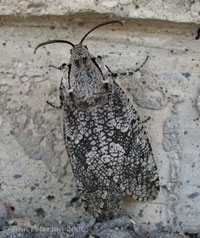Prinoxystus robiniae
Hosts
Ash, Cottonwood, Elm, Maple, Oak, Poplar and Willow

Photo credit: Fermilab, U.S. Department of Energy
Appearance and Life Cycle
Adult carpenterworms are stout-bodied moths that are present from June to July. The forewings of the males are mottled with grey and brown scales and have a wingspan of approximately 50 mm. The top half and margin of the hind wings are dark brown, while the lower half is yellowish-orange. The females are twice the size of males, are lighter in colour and have a wingspan of approximately 75 mm. The hind wings of females are a smoky-grey colour. After mating, females deposit eggs in groups of 2 to 6 on living trees. Each female produces between 300 to 450 eggs. The eggs measure about 2.4 mm long and are an olivebrown colour. After emergence, the larvae enter the host by boring through the bark or entering through wounds or scars. The larvae are reddish at first, then change to a greenish-white. The larval stage takes 3 to 4 years to complete. The larvae begin feeding on the outer and inner bark and then tunnel upwards into the heartwood. Sawdust and frass pushed out of the tunnels and clinging to the outer bark indicates the presence of carpenterworms. Full grown larvae are 55-75 mm long and are greenish-white with shiny, dark brown heads. Larvae develop into dark, shiny-brown pupae that are 35-50 mm long. Before the adult stage, the pupae move down the tunnels until their heads and thoraxes protrude from the tunnel mouths. After the adults have emerged, the empty pupal cast- ings remain, sticking out of the openings.
Damage
Extensive tunneling by larvae weakens trees causing breakage during strong winds. A heavy carpenterworm infestation seldom kills trees outright, but it allows other insects and diseases to enter, which may kill the trees.

Photo credit: E. Beers, wsu.edu
Control
There is no recommended insecticide available to control carpenterworms. Birds are the most important means of controlling infestations. Carpenterworm infestations can be reduced by removing and burning heavily infested trees. Some control can be achieved by probing the tunnels with a wire. Young trees can be protected by wrapping burlap around the trunks from May to August. This prevents adults from emerging and eggs being laid on the bark.